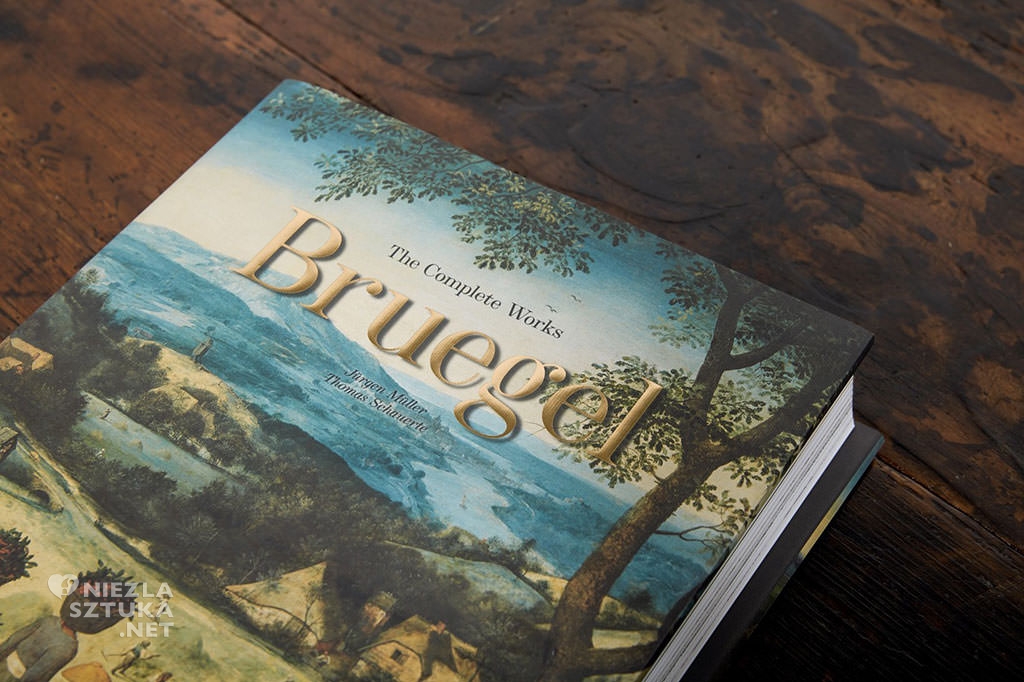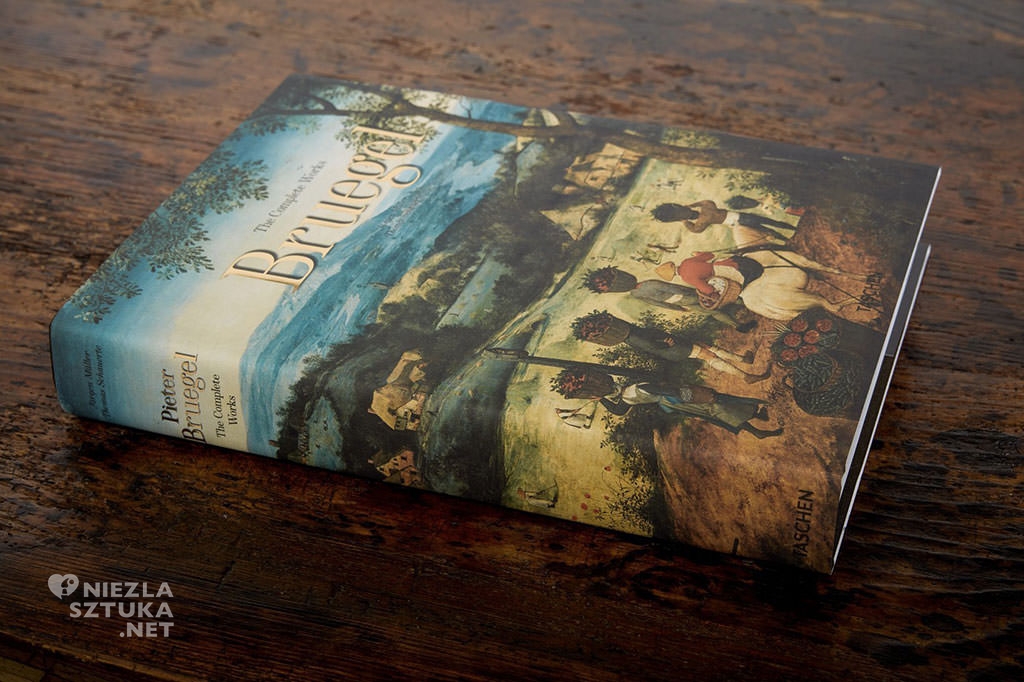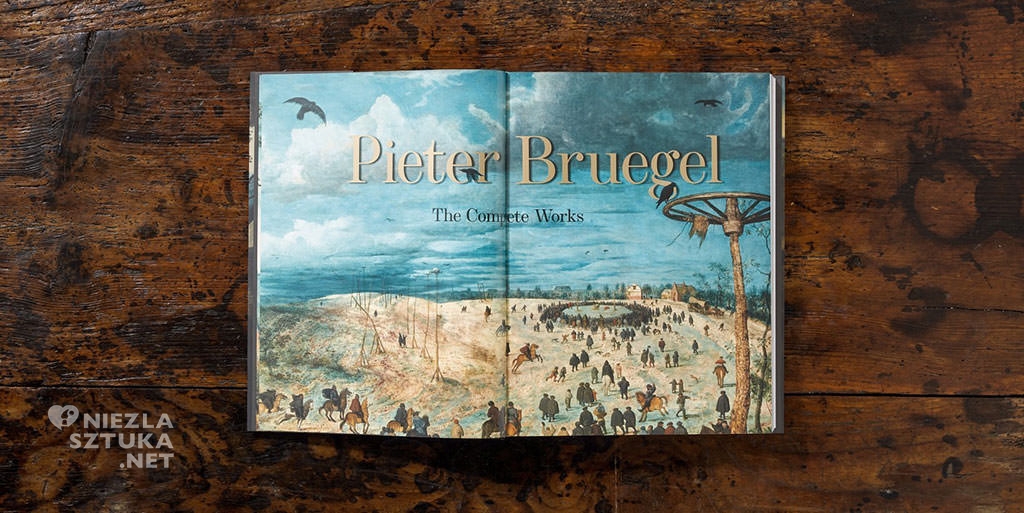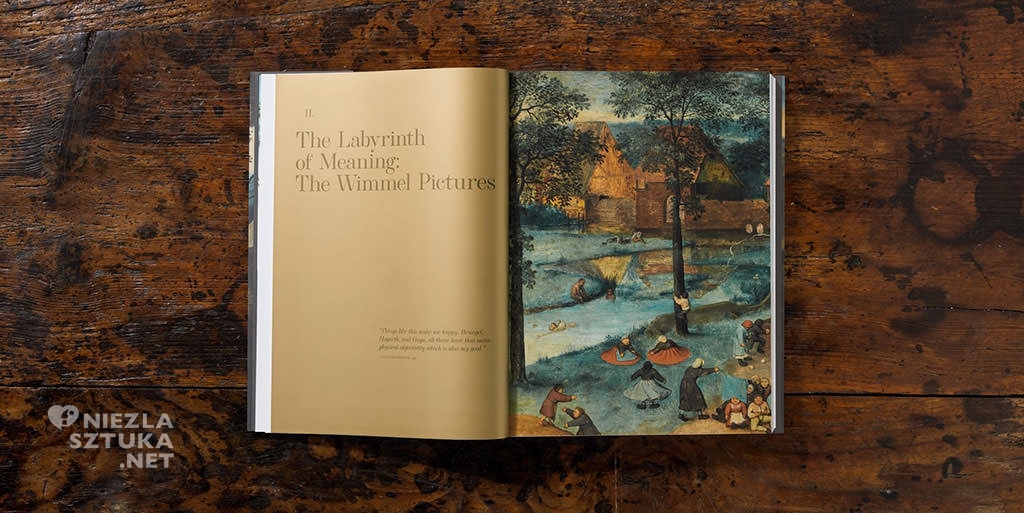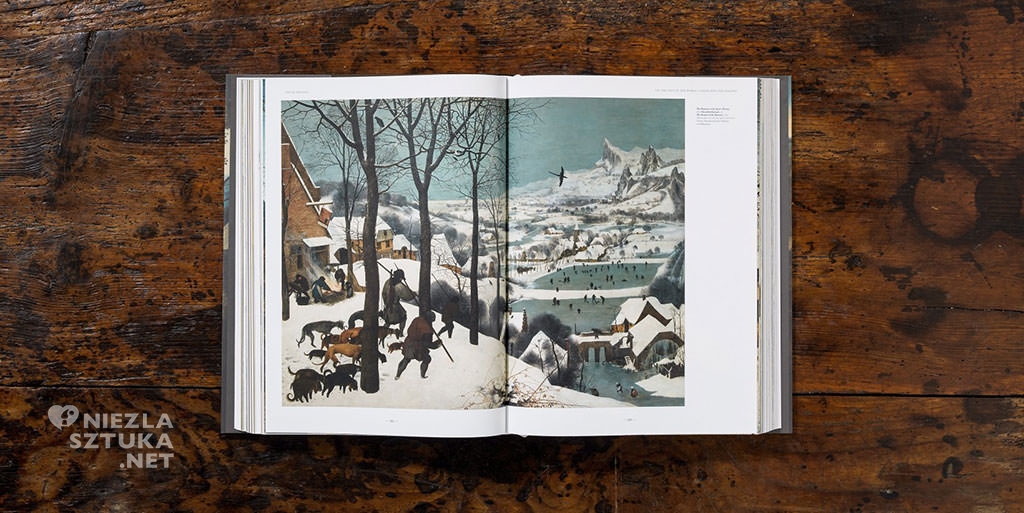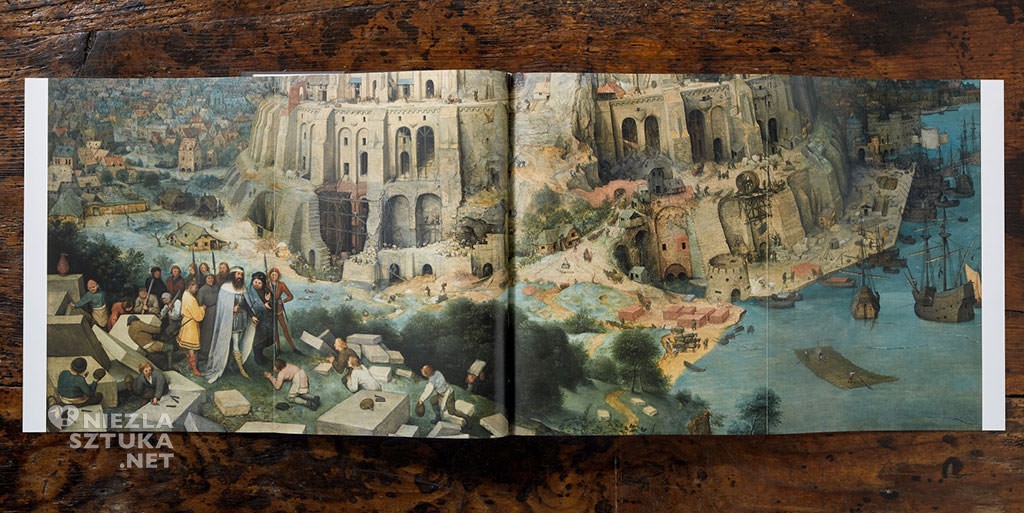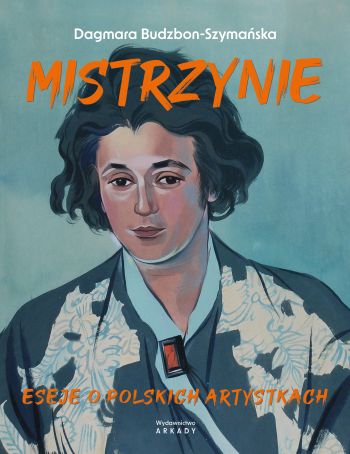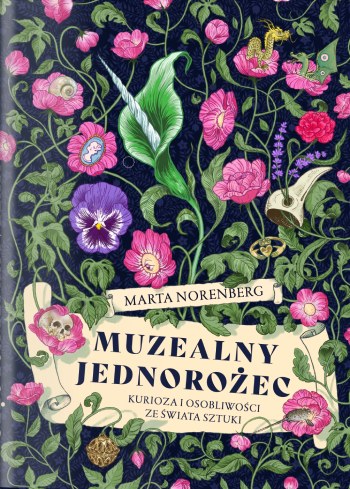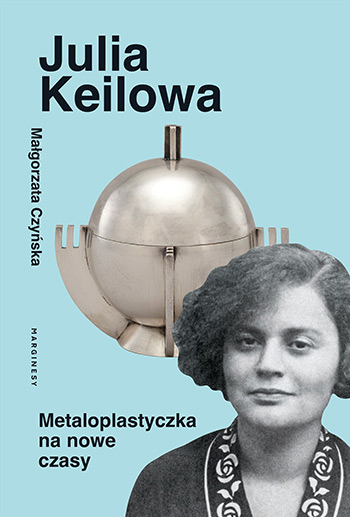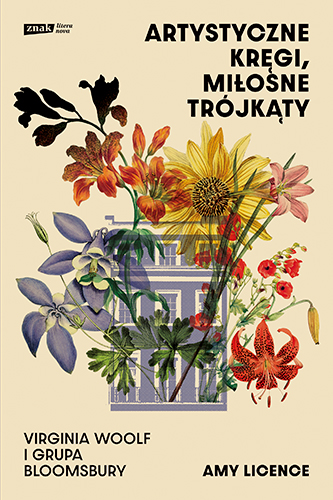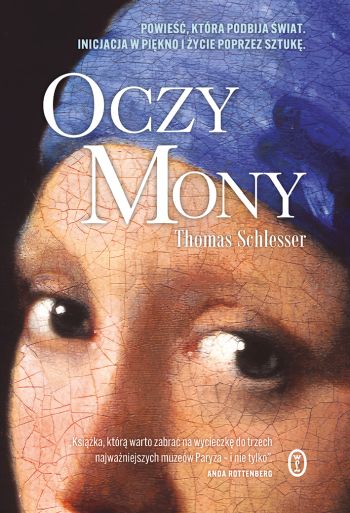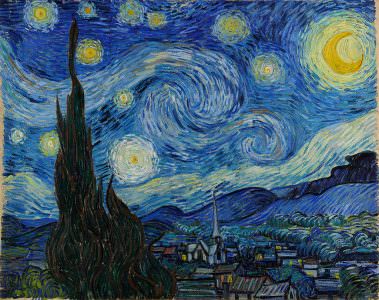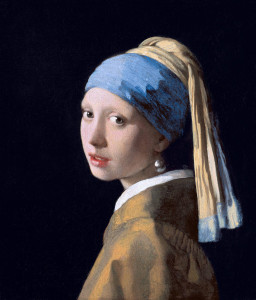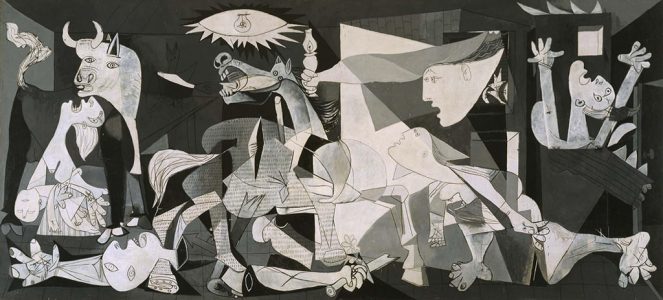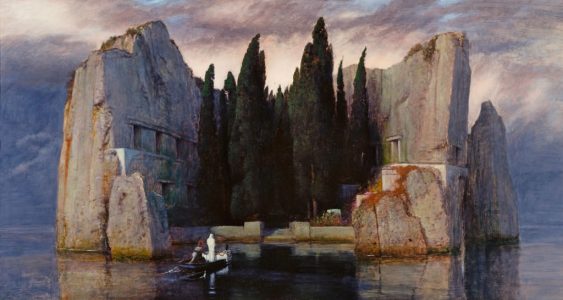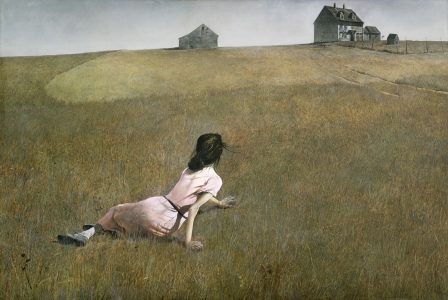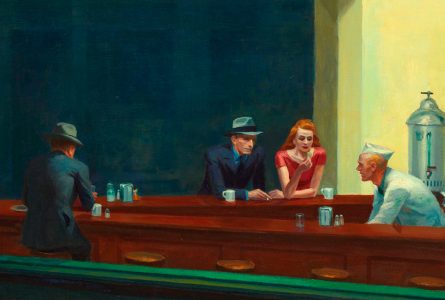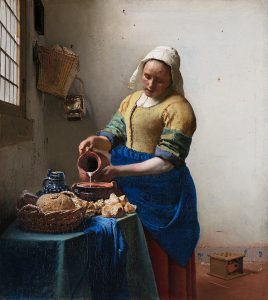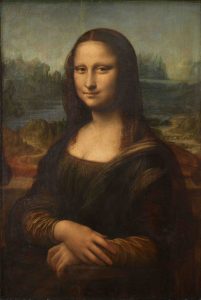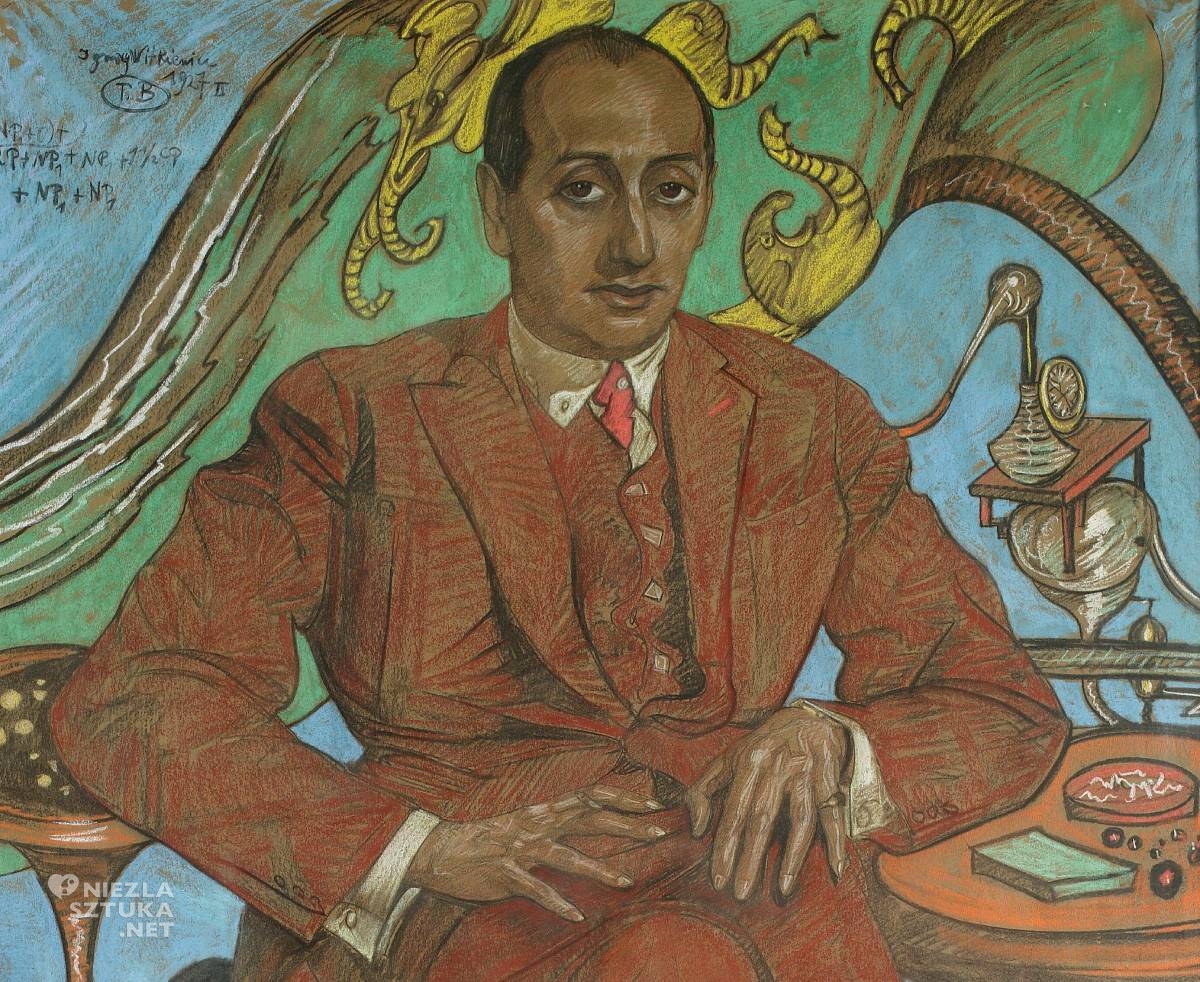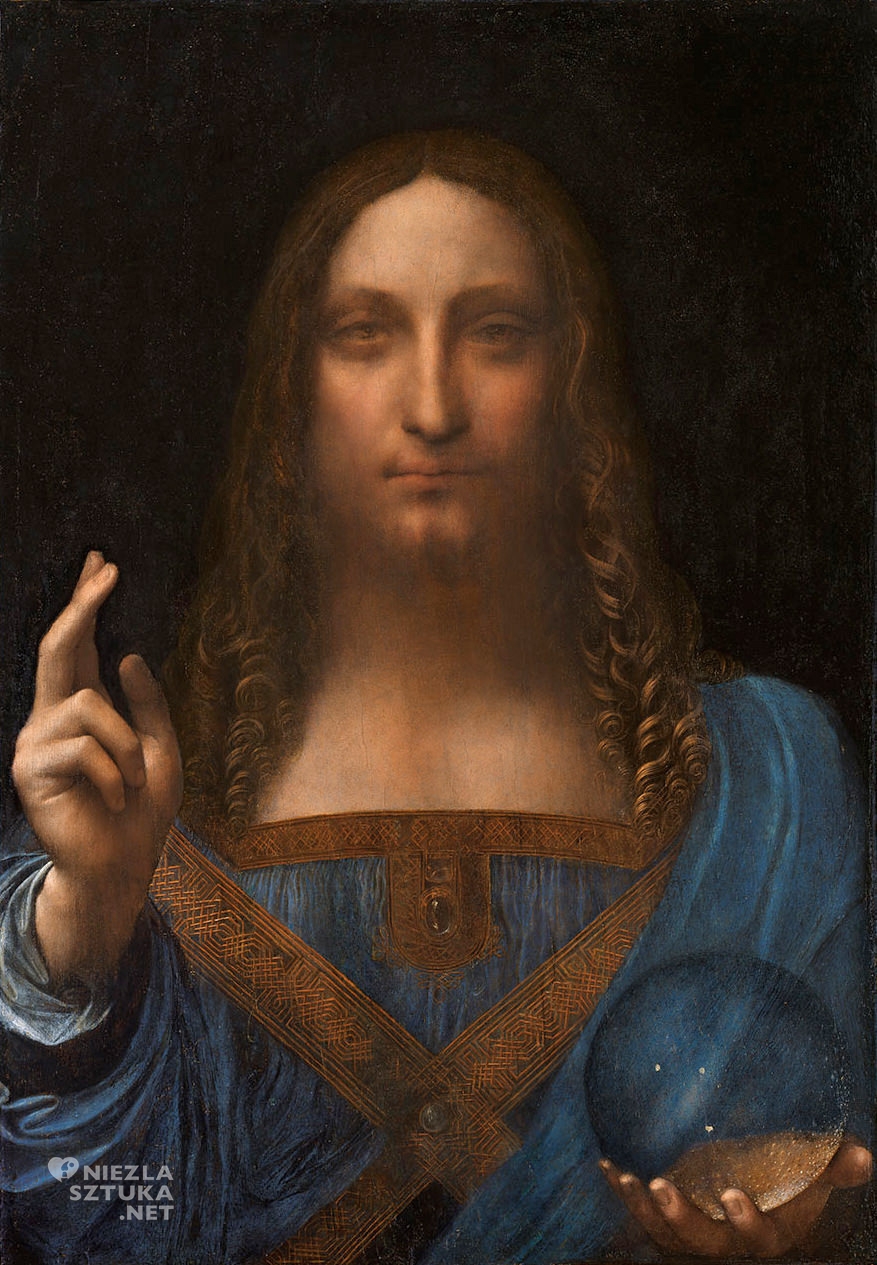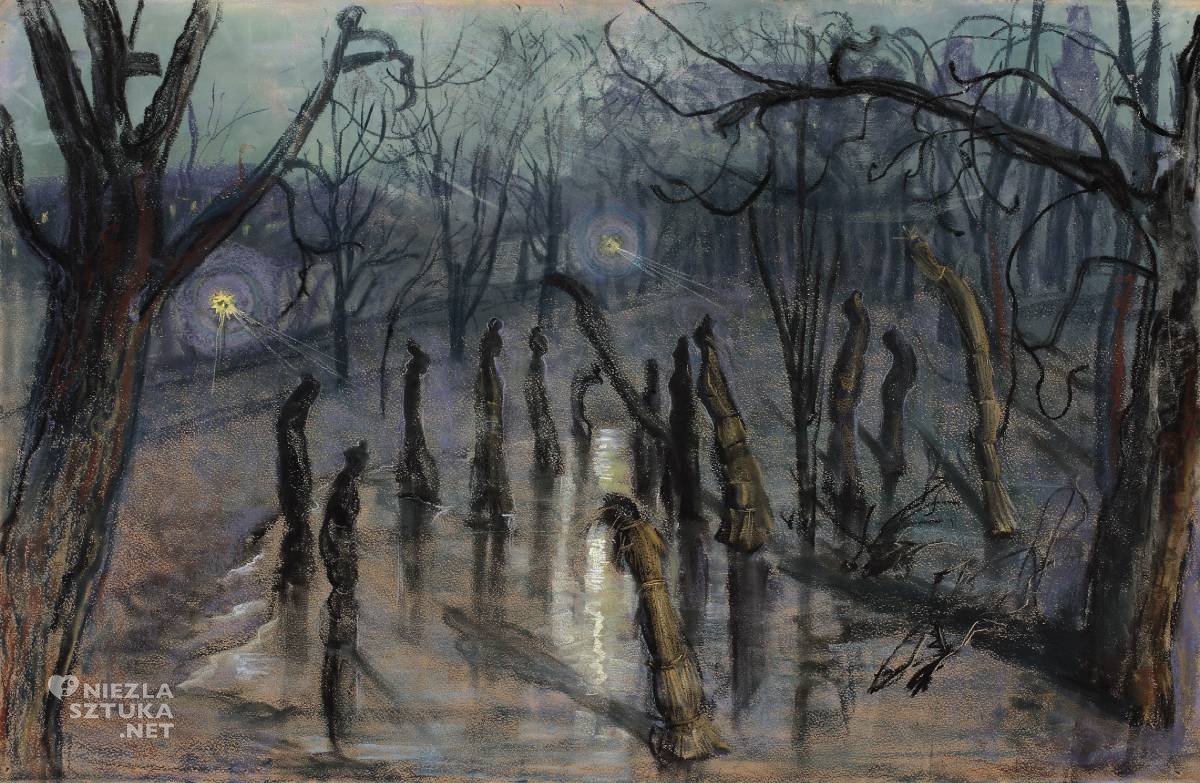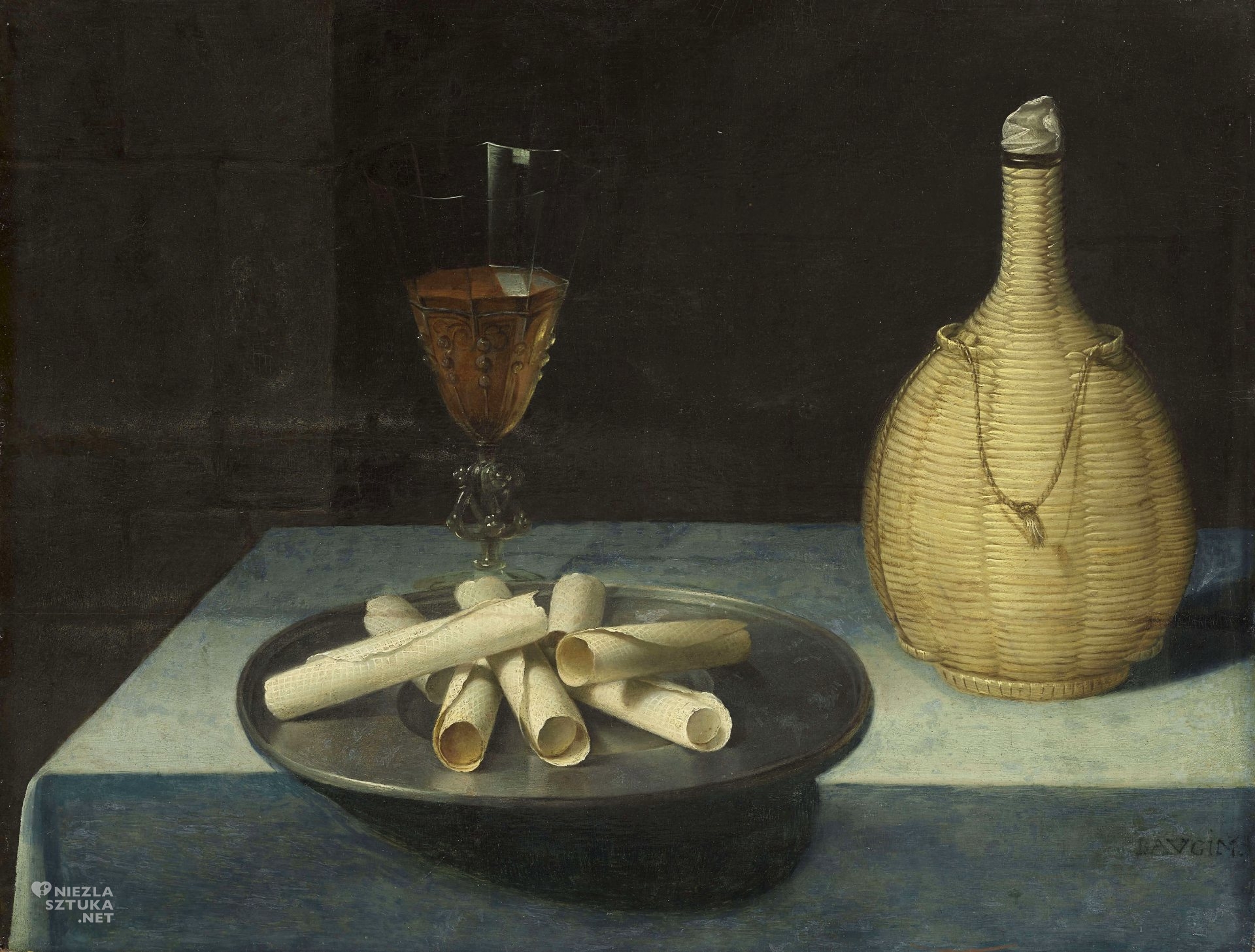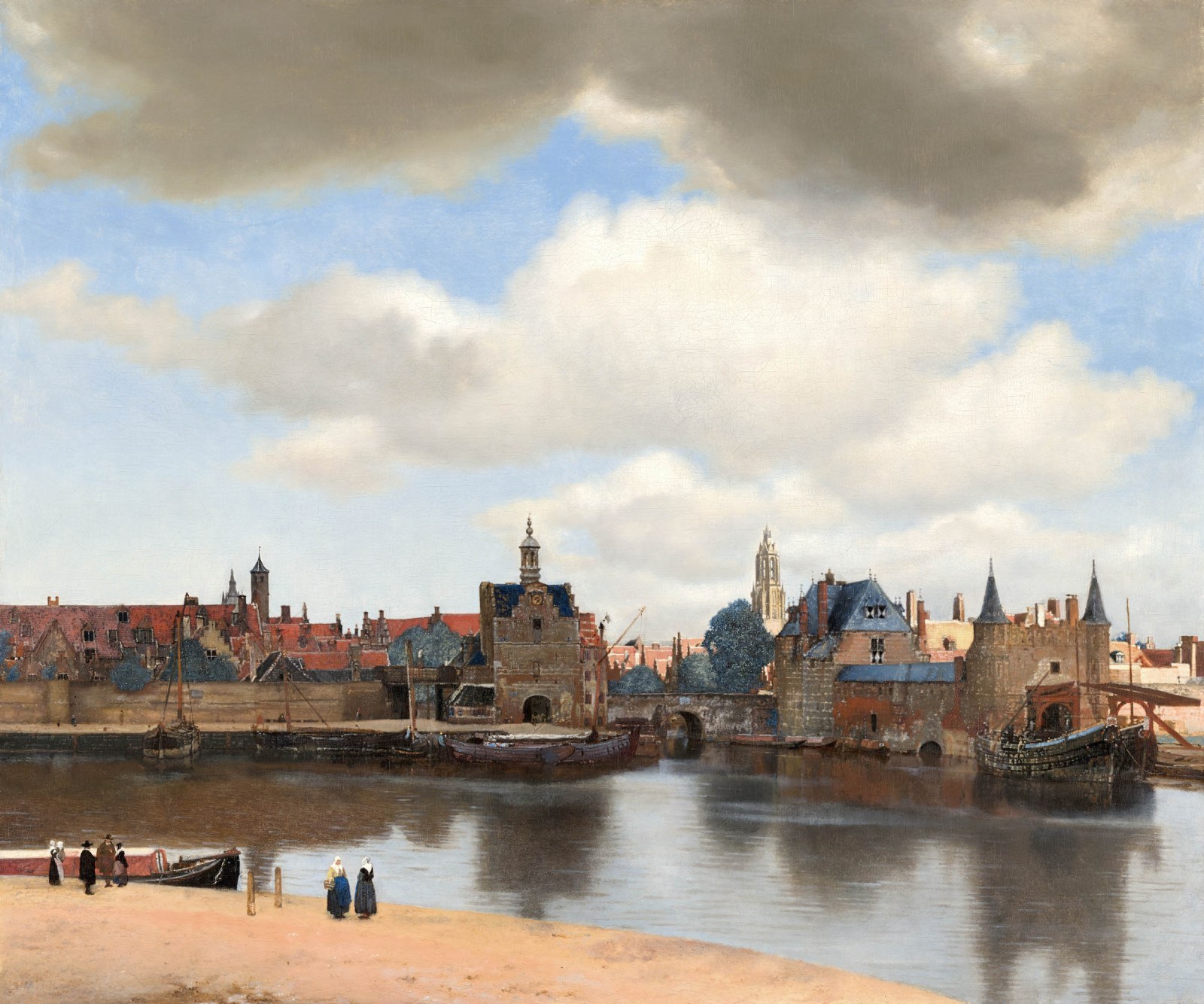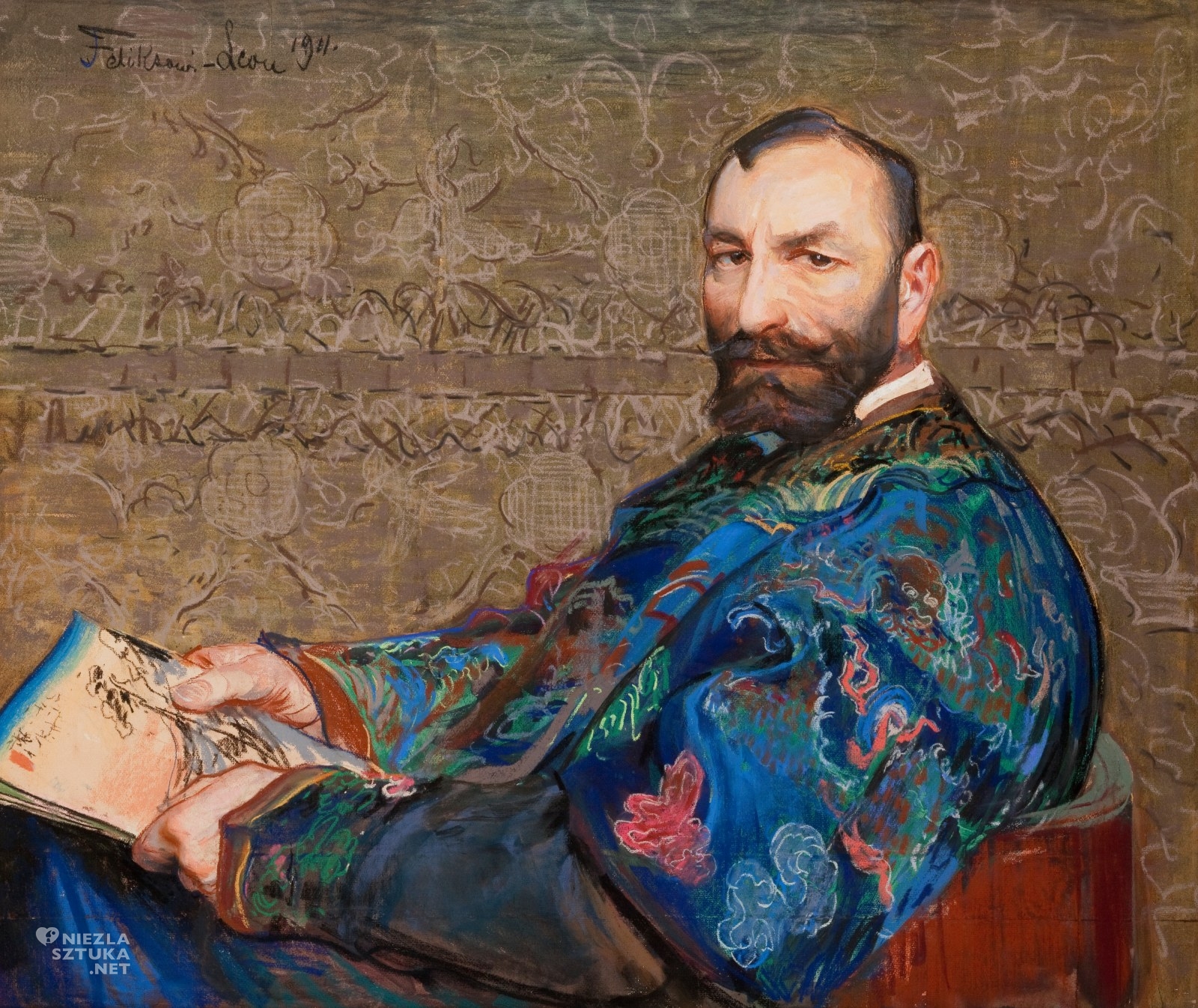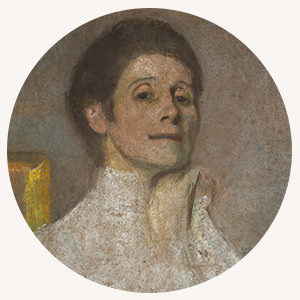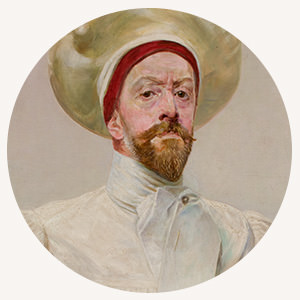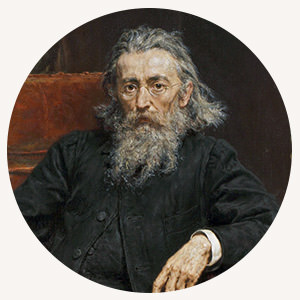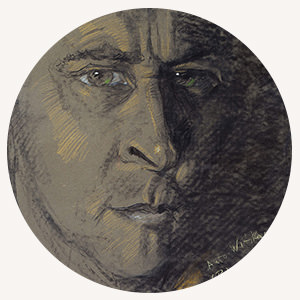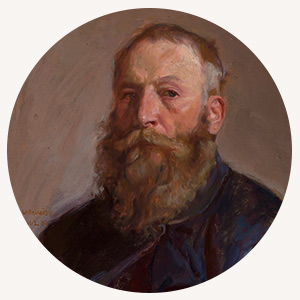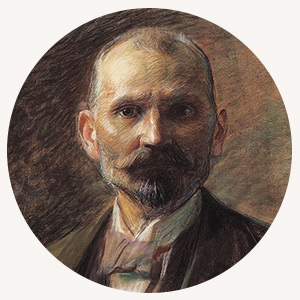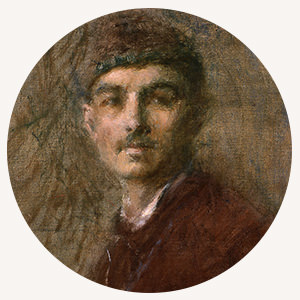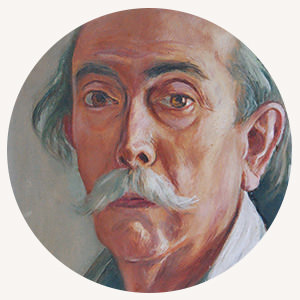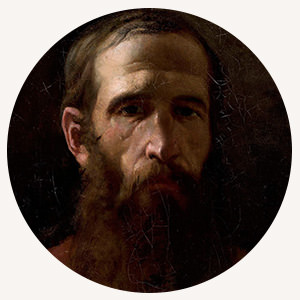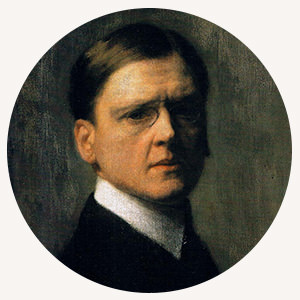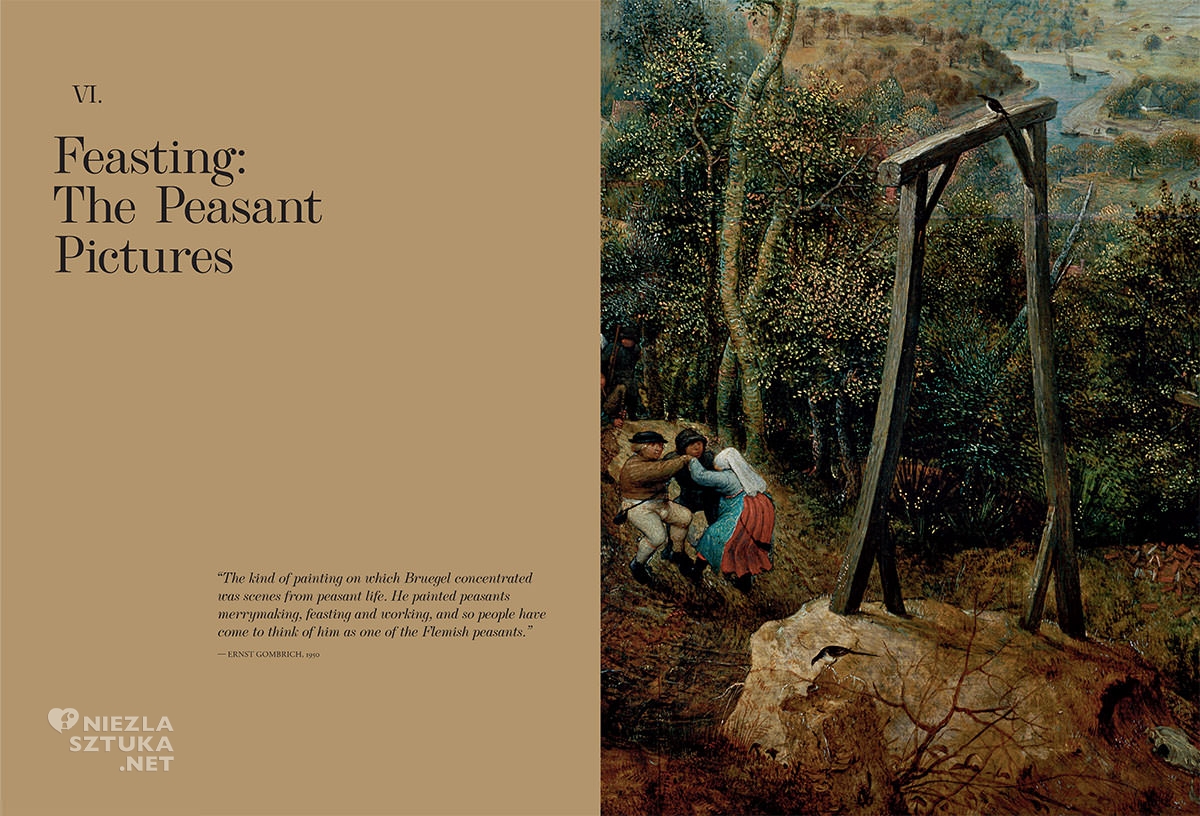
fot. Dzięki uprzejmości wydawnictwa ⓒ Taschen
The dancing gallows
Bruegel’s The Magpie on the Gallows (pp. 180/181, Cat. 37), dated 1568, is one of the most enigmatic of his inventions, featuring a peculiar mixture of the peasant theme and landscape.
We are looking from a high vantage point down into a valey, where we follow the course of a river leading from right to left as far as the horizon. At first our impression is dominated by the enchanting atmosphere of the landscape. Brown, ochre and green tones contrast with the delicate grey and purple nuances of the horizon. For this almost square picture, Bruegel creates the view into the distance by framing his narrative on both sides with trees. This repoussoir also has the task of intensifying the impression of great depth. It is a fine summer’s day, and people are enjoying the light and warmth of the evening sun. In the bottom left-hand corner, we see people dancing and making music, Bruegel accentuating them through the colours of their clothes. In the shade of the trees, we detect a man with his hose down, and among the people arriving another man heads urgently into the brushwood to urinate. In the crowd, we also spy a bagpiper with a red, pancake-like face inciting all to dance. We cannot discern the cause of the festivities here. However, none of the people dancing, music making and gesticulating in abandonment seems to be registering that they are entertaining themselves under a gallows. A magpie is perched on its cross beam, and a second crouches in front on a stone, watching the dancers and their actions (p. 167).
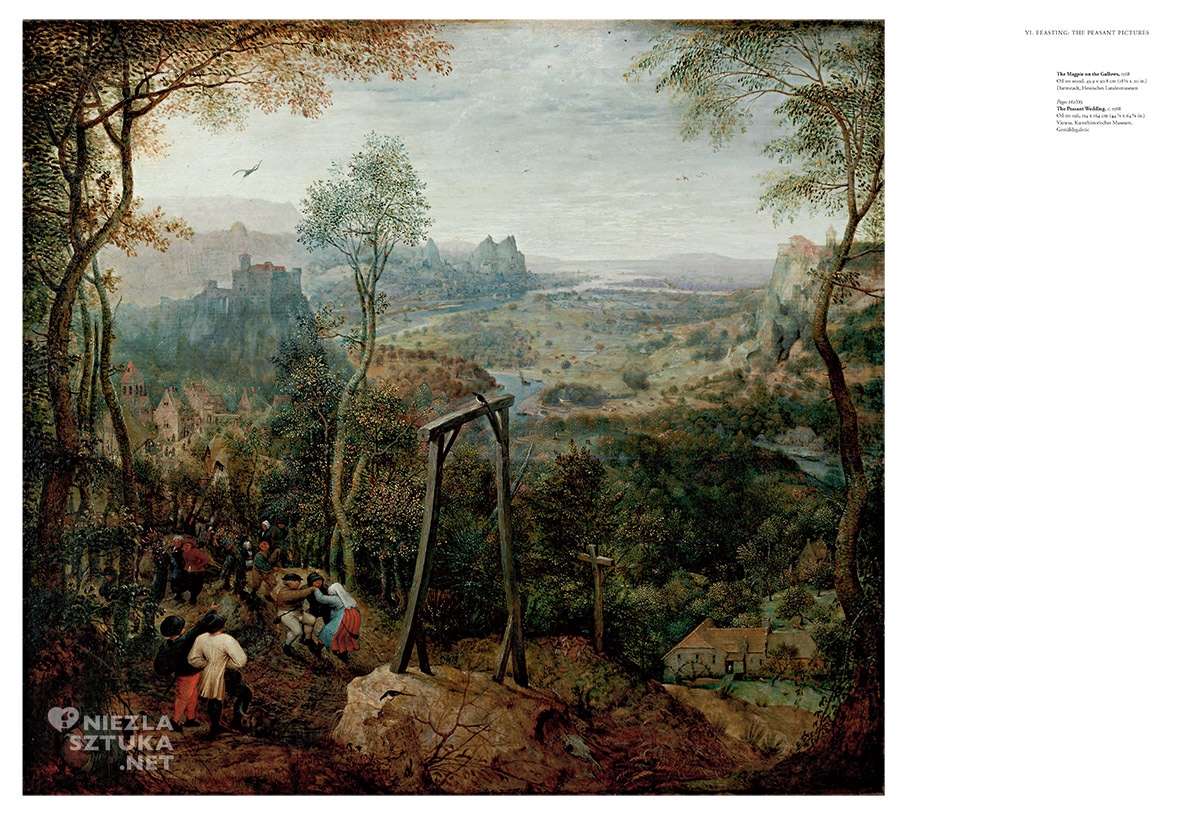
Pieter Bruegel The Magpie on the Gallows, 1568 fot. Dzięki uprzejmości wydawnictwa ⓒ Taschen
To the right of the gallows is a horse’s skull, marking the location as a place of butchery. Alongside the trees on the left, in the direction from where the people have come, stand a church, a tavern and the houses of a small town, while our glance passes right of the gallows to a cross and a watermill. The picture is enigmatic; the elements do not add up to a whole, but stand incongruously separate in this panoramic Weltlandschaft – “world landscape”. At all events, the crane flying high at the left is placed so prominently and majestically in the sky that questions arise as to its significance.
Bruegel’s picture was produced in the heyday of the Inquisition, and so attempts have been made to interpret the magpies as a critical reference to this institution. This is justified to a certain degree, if we remember how van Mander characterises the picture. He mentions it at the end of his biography of the artist and emphasises its controversial content: “In his will he left his wife a picture with a magpie on the gallows. By the magpie he meant the gossips, whom he dedicated to the gallows.”
With this episode the biographer alludes to the danger of possible denunciation and quotes the magpie as a symbol of scandalmongering and frivolity. If we keep in mind the danger in which Bruegel’s widow found herself through his all too critical motifs, gossips are perhaps not meant here so much as the denunciators who would betray dissenters to the Catholic Inquisition. Do the men at bottom left standing with their backs to the observer, and apparently coming from a different direction from that of the peasants, correspond to the two magpies and provide an explanation? Does the motif of the crane flying away represent a warning to keep one’s peace in religious matters? And what significance does the watermill have, which is being trodden by one person at that moment? All this remains ambiguous.
At least we may say that the peasants, instead of quaffing in the tavern or on the square in front of the houses, have gone out to entertain themselves in the shambles. They do not blench before the macabre place riddled with rotting cadavers. They follow nature’s call, they are themselves part of the order of creatures subject to becoming and decaying. So they are not capable of looking beyond their physical well-being and hence of recognising the cross below the gallows, but remain captive to a world of physical needs and sensual desires. It is instructive how closely death and pleasure are juxtaposed here. There may be a certain significance in easily visible millwheel; it alludes just as much to the Wheel of Fortune as it does to the ever-recurring Passion interpreted by Franck, and also to The Procession to Calvary (Cat. 15), as we saw before. At any event, the horse’s skull crops up in both pictures as an attribute of the shambles “Golgotha”. It cannot be determined if the picture as a whole might be seen as a warning against denunciation, or about peasants who turn to the gallows and not to the cross, who, to quote the blunt saying, even “shit” on it.
What is striking is the peculiar multi-perspective rendering of the gallows. Bruegel is inventing a paradox here. While the cross beam at the top projects obliquely into the space, the vertical supporting beams seem to be parallel. We cannot observe this gallows framework without its form constantly changing as we look at it. Bruegel studies have asked whether he was indulging here in a trompe l’oeil, wanting to depict a “dancing” gallows. An interesting feature of this ambiguous image is that its shape-changing cannot be stopped. Even after its construction has been understood, its cavorting cannot be “deactivated”, so that we are fooled, time and again. Reality as a presence assured by the senses is being denied. The crazy gallows remains in our memory, seeming to mock us again and again, but also the senseless hustle and bustle of the peasants confronted by an inconceivably beautiful world.
The Last Day
The Viennese Peasant Wedding (pp. 182/183, Cat. 31) has always been regarded as an exemplary expression of Bruegel’s art. Van Mander tells of how the artist, along with his friend, the merchant Hans Franckerl, dressed up as peasants and went to country weddings to study the people there undetected. We are cautious today about the truth of such anecdotes. But of course this caution does not spare us the question of why the biographer mentions Franckert’s name – Bruegel could, after all, have gone to the weddings on his own.
An adequate explanation has never been provided for this curious episode in his biography. It wasn’t noticed that Bruegel has portrayed Franckert in the Peasant Wedding at the far right edge of the picture. Van Mander possibly mentioned the episode because he was familiar with the profile portrait of the Nuremberg man from a medal of Jacques Jonghelinck’s (1530–1606). So we may presume that Bruegel had a very close relationship to his patron, otherwise he would never have dared portray him in all the carousal of a peasants’ wedding.
Admittedly, the literature of the first half of the twentieth century concentrated far less on such suppositions than on Bruegel’s robust style in his portrayal. It was thought to demonstrate his closeness to the “folk”, genuinely expressed in his peasant pictures. Our response to the Wedding Meal or Peasant Wedding – it is known by both names – dated around 1568 is at first monopolised by the few figures in the foreground. Even before we detect the actual theme or analyse the many actions, we see two men carrying plates on an unhinged door to the table crowded with the hungry wedding party. The light-blue jacket and white apron of the man walking behind stand out from the dominant yellow-brown tones, thus immediately striking the viewer’s eye.
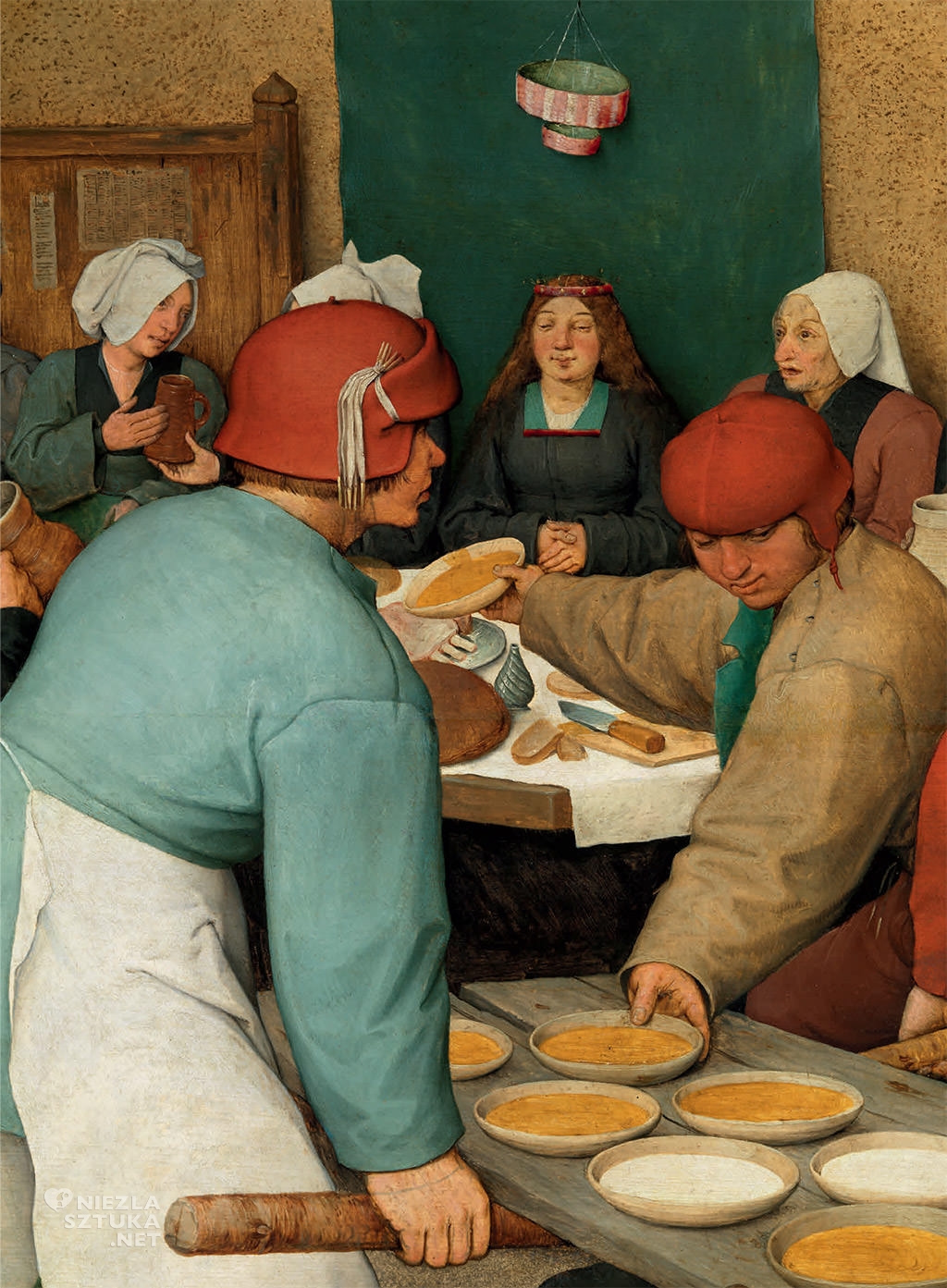
Pieter Bruegel, The Peasant Wedding, detail, c. 1568, fot. Dzięki uprzejmości wydawnictwa ⓒ Taschen
In comparison with the other people, the two plate bearers are shown disproportionately large. Their monumentality accentuates the heaviness of their burden. After this, our eye is caught by the man in the front left corner of the picture; he is filling a jug with ale. A child is seated next to him, wallowing in the memory of the porridge he has just eaten, a piece of bitten-into bread and butter lying on his blue apron. Only after perusing the figures in the foreground do we gradually take note of the persons around the table. This carefully considered address to the observer in accentuating the foreground leads to a perspective effect upon the action. Even before we can turn to the many people present, food and drink is established as the defining context.
The people are seated together crowded elbow-to-elbow around the table. Overall, we find a colourful wedding party assembled here. Behind the bride in black is a greenish-blue cloth, and a crown hangs above her head. In keeping with tradition, she sits still and isolated in the midst of chattering and laughing people. She has her eyes closed and grins in a private reverie – we cannot avoid the strong impression that this is because she’s tipsy. The red hat adorned with a peacock feather worn by the porridge-slurping child in the foreground is much too big for him. Someone could have pulled it over his head. Since everyone present is wearing some sort of headgear, maybe the one who did this has vanished from the observer’s view and is busy doing something that a headdress with a peacock feather would impede.
To the right of the bride are her mother and father, at the left a young woman (obscured by a man’s headgear) who is handing her neighbour a tankard. The father of the bride stands out from the other guests because he is the only one sitting on a chair with a backrest, while all the others have taken their places on simple benches, or have improvised with tubs and baskets.

Pieter Bruegel, The Peasant Wedding, detail, c. 1568, fot. Dzięki uprzejmości wydawnictwa ⓒ Taschen
The long bench at the left seems to have been made especially for the occasion – the bark seems fresh and the wood lighter than the bench we can see on the right. For the observer, it is evident that more guests are turning up at this party than have been hosted by the bride’s family before. Musicians with bagpipes entertain the party. The strenuous bustle in serving the ale and in handing round the porridge shows that the wedding party is in full swing.
Compared with the traditional chastisement of vice inherent in the peasants’ wedding motif, Bruegel’s critique is discreet, only visible at second glance. Hence the more riotous drinkers are seated not at the top but at the bottom end of the table, so we see them relatively late. But eventually we note the many ale tankards the men and women are voraciously raising to their mouths. Bruegel’s intention is critical in portraying these drinkers, also evident in the fact that their faces are all covered by their raised tankards, seemingly robbing them of their identity. In the literature, the chastisement of vice was emphasised as the most important function of the peasant pictures, with a repertoire of fixed types and actions attached to the genre. In no way is an empathetic portrayal of his own country folk evident in the theme.
The focus here is on intemperance and unchaste behaviour in a whole series of scenes. Everywhere, everyone is “quaffing” and “guzzling”. At the far end of the table, a women is handing a tankard to a handsome blonde. The child next to her is hers and shows she is a married woman. It’s not clear if her husband is the one on her left being spoken to by another woman, or the one round the table corner placing a tankard to his lips without wasting a look at his surroundings. What is clear is her interest in the man leaning over her to whom she is handing the drink.
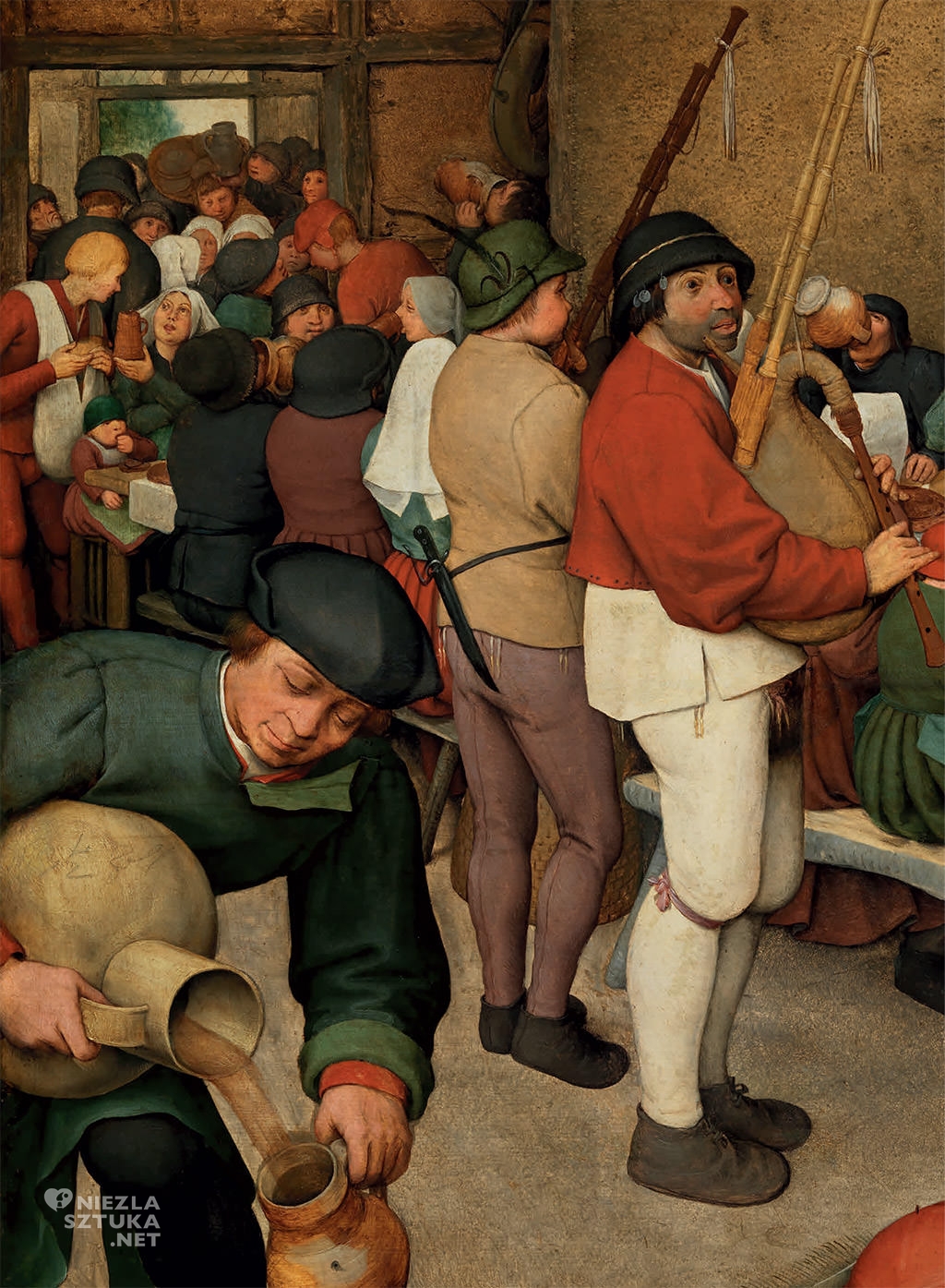
Pieter Bruegel, The Peasant Wedding, detail, c. 1568, fot. Dzięki uprzejmości wydawnictwa ⓒ Taschen
Not only the actions of those present are characteristic of vice; so is the location. The party is taking place in a spacious barn; we can see the straw stacked high behind the party table. Two stout wooden beams are placed between, bearing the weight of the barn roof. The entrance is at the far end of the room, and through it we can detect a timber-framed wall. It is surely no coincidence that Bruegel endeavours to make the straw correspond optically to the rendered walls. Only at second glance does it become clear that the rear wall is not a rendered timber-frame wall, but simply a wall of straw bales.
The barn with its hayloft may be seen as reference to a disreputable location. It is staged figuratively as a place of lust. Thus in the left rear corner we can see a ladder leading up to the straw. A reddish-brown cover is hanging above it on the beam, its colour alluding to love and lust and making the concealed love nest there even more enticing. A pigeon is perched in the barrel hanging on the wall, another hint of the erotic context.
The serving of plates with milk-and-oats porridge on an unhinged door is not a simple undertaking, as is distinctly seen in the foreground scene. The two men make their way forwards tentatively, but their movements do not seem in unison. While the man at the front staunchly steps forward without consideration of the man at the rear, the latter has to counteract the ensuing unsteadiness. The two figures have a third person allotted to them. The man seated at the end of the table takes the porridge dish with his left hand to pass it on to the hungry party with his right hand. Bruegel has indulged in a mischievous joke at the expense of this trio. The door is at the moment covered all over with plates, but an imbalance will soon occur (pp. 168, 171) – the half of the door relieved of porridge plates will be too light and the whole thing will tip over.
In an ironic vein, Bruegel shows a misfortune that will happen without our being able to see it. He lets the future invade the present. No less skilful is the running gag of the man serving ale in the left corner (p. 172) – every time the observer looks over at this figure, he sees the jug has by no means been emptied in the meantime. The ale flows and flows…
The literature has noted that the theme of the wedding in general – above all the motif of the serving man in the foreground at the left – offers an iconographic reference to the Marriage Feast at Cana. This is plausible also because Bruegel has based his composition on a corresponding picture, probably the work of his teacher Pieter Coecke (p. 170). Here, too, there is a similar structure with a table placed obliquely in the room, reinforcing the sense of depth.
With the iconographic reference to the Marriage Feast at Cana, Bruegel’s Peasant Wedding is given an allegorical dimension, first of all ex negativo. The biblical narrative alludes to the shortage of wine as a symbol of temperance, which is entirely missing here amongst the carousing peasants. Traditionally, the story of the miraculous increase of wine has an eschatological significance. Jesus responds to his mother with the words “my time is not yet come”, only to then transform the water into wine. This tastes much better than the wine set forth for the guests by the bridegroom, thus it offers a foretaste of the coming of the Messianic kingdom.
Bruegel’s allusion to the Marriage Feast at Cana may also be pointing a warning finger towards the Last Judgement. The party indulging itself in so carefree a fashion in pleasures of the flesh would then be an allegory of the sinful world. Especially the child delighting in his porridge is a curious symbol of seduced, oblivious mankind – the peacock feather is a clear sign of this.
But it is not only the boozing party that supports such an interpretation; the subtle staging of the event leads us far more along an apocalyptic trail. Merely the supposed fun Bruegel permits himself with the loaded door hints at the precipitous change threatening the wedding. We must only look at the horrified glances of the bagpiper and of the guest at his right, staring at something terrifying at the right, outside the picture space. These looks also become indirectly thematic through the bride’s father and the mother, who have noticed the horrified men and are now staring at them as though stunned. Also the guest to the left of the bride spooning up his porridge is staring in fright towards the seated man with a green hat, who is apparently so shocked that he has even put down his tankard.
Only now do we realise how subtly Bruegel is playing with the motif of time. His first concern in his picture is to suggest the continuum of time. Everyone is joining in the revelling, drinking and eating with great gusto. The ale flows like the wine at Cana. But, simultaneously, the artist provides clues that hint at the end of the world and time itself.
Only within this context can we recognise the full sense of the figure in the foreground at the left, since the diversion with the never-ending supply of ale contains a reference to the “measure is not yet full”, the “time is not yet come”. Together with the walls of straw and wheat stalks lying around, we are reminded of the sentence “the chaff that is separated from the wheat” (Matthew 3: 12), again an allusion to the end of time and the Last Judgement.
Now the question arises regarding the significance, in this context, of the two men at the right edge of the picture. Here, seated at the furthest end of the bench, are a Franciscan friar and an elegant patrician whom we have identified as Hans Franckert. Friars and monks could of course join in a peasants wedding; we only have to look at an engraving by Pieter van der Borcht (p. 173). But they appear to be just as riotous as the other revellers and keep up with the gluttons with no difficulty. Whereas in Bruegel’s picture, someone is apparently being shriven. The warning of the friar and the readiness for penance of the man who, with lowered eyelids, is contemplating the state of his soul presents an alternative to the behaviour of the other guests.
Dancing on the brink of the abyss
It seems obvious to see The Wedding Dance (pp. 184/185, Cat. 25) and The Peasant Wedding as counterparts.

Pieter Bruegel The Wedding Dance, c. 1566 fot. Dzięki uprzejmości wydawnictwa ⓒ Taschen
They have almost identical formats and are complementary in theme. The dance follows the meal, and so the party has moved outdoors to continue their revelling. We have the impression that the erstwhile mildly smiling bride from the barn has been transformed into a wildly dancing young woman, yet, through her chaplet and her high-flying blond hair, she remains recognisably one and the same person. If we see the pictures as counterparts, we are challenged to set up a connection between them. So how is the theme of the impending end of the world applicable to such a hedonistic feast? This doesn’t seem to make sense, and so all interpreters have rejected a deeper meaning in the picture and have seen the chastisement of vice as the pictorial agenda.
In the foreground on the right, we can make out two bagpipers entertaining the party. Bruegel has succeeded wonderfully in transporting the rhythm of the music onto the dancers’ movements. What especially strikes the eye are the codpieces of the men in the foreground, so big that later owners of the picture had them painted over. The dancer on the left is approaching his partner in a particularly ribald way, flaunting the size of his manhood. He supports his hands on his hips and his tight jerkin is stretched across his belly. His partner seems to be joining in the fun and imitates his posture. She excitedly performs rapid tripping steps to the music. The dance is represented here unambiguously as a sexual game.
But we note that the face of the attractive woman dancer is far too small. She is defined through her body. A couple to the right of this scene have even interrupted their dance to kiss. Above the former couple we also discover a passionate embrace. And far distant in the background where improvised grassy banks have been set up we see another couple who are not content simply to dance with each other.
While provocative movements dominate the foreground scene, the people in the centre ground have got together to talk. On the left, a young man in a red jerkin and with a head that is much too small has approached a group made up of father, mother and daughter in order to ask the young woman to dance. She glances shyly to the side, while the parents eye the “cavalier” sceptically. The intemperate drinking, such as we have encountered in The Peasant Wedding, plays a relatively small role here. The only comparable drinking elements here are a man pouring ale into jugs, and, opposite, above the bagpiper, a man holding a jug to his mouth. The riotous dancing and its association with sexual attraction form the dominant theme of the picture.
From the technical point of view, Bruegel seems to be intent on representing an extremely large group of people in the most confined space. No fewer than 125 wedding guests can be counted in the picture. We can perceive the persons in isolation, but also as a connected, heaving mass. It is as if Bruegel wanted not only to portray a wedding party, but also a symbol of mankind. The picture, with juxtaposition of colourful and monochrome colours, seems almost to pulsate. The ochre, brown and green tones are placed next to red, white and blue. It is this dynamic carpet of colour that gives the eye no rest.
Once again Bruegel exploits a distinctive method of composition. In The Wedding Dance, he allows the picture space front right to fall off so sharply that we fear the figures positioned there at the bottom edge might fall off the picture into an undefined abyss. Especially the dancer in a tight white hose flinging his limbs around and chasing his partner with much whooping is in danger of falling into nothingness. At any event, Bruegel is giving us a hint here that the bride is the most important figure in the picture, for our vantage point is on the same horizontal axis as the young woman’s face, thus requiring a higher viewpoint. She dances wildly with a partner, whom we can hardly identify as her bridegroom.
Bruegel has had to address a structural problem as a consequence of the steep fall off of the pictorial space, since it was necessary to include optical counterweights in order to prevent this disturbing moment from disrupting the picture’s overall impression. Therefore, he uses a strongly rising pictorial space to generate an immense pull into its depth towards the horizon; this is supported by the rising diagonals left and right. In addition, the raised, entwined arms of the dancers act as signposts towards the depth of the pictorial space. We might mention in this context the enigmatic figure of the darkly attired man in the front corner at the left, who is standing in extreme shadow under a tree. In technical terms, he provides an optical brake: he prevents the wedding party from slipping off the picture, as it were – the ground seems considerably flatter in his immediate vicinity.
We could continue describing scene after scene to illustrate Bruegel’s richness of invention. But it has become quite clear that the panel has succeeded in two tasks. Firstly, it responds to the technical demand of diversely portraying an extremely large group of people. Secondly, the artist stages the allegory of oblivious humanity lost in debauchery, who are dancing at the brink of the abyss without being aware of the impending danger.
The picture’s narrative is clear. However, the panel can be variously understood, depending on whether we perceive it with or without a connection to The Peasant Wedding. The connection between the approaching Apocalypse and the metaphor of the bride as sponsa Christi can be understood as an argument critical of the Church, which is not immediately detectable in The Wedding Dance Outdoors. The bride has not succeeded in her task; so, as Bruegel sees it, she relates to superficially experienced faith. Bruegel’s achievement consists in making us forget the allegorical dimension of the picture by using a visual argument. The prerequisite for understanding the picture is based not only on an awareness of the symbolism of the bride, but also the overall view.
If Bruegel juxtaposes vice with the approaching end of the world in the two pictures, this is in no way new. On the contrary, Sebastian Brant, in his popular Ship of Fools (1494), already saw an unmistakeable sign of the approaching end of the world in the increase in debauched, immoral behaviour, which he perceived in the times he lived in. And the eschatological mindset plays a central role most particularly in the writings of Sebastian Franck. In his Geschichtsbibel (History Bible) and in the early Vom greulichen Laster der Trunkenheit (On The Horrible Vice of Drunkenness), both translated into Dutch in Bruegel’s time, we find writings on the Apocalypse. Franck sees it as a mystery, its date unknown. At the same time, he describes the oblivious state of the world that will be caught unprepared for this event.
Laughing or crying?
From the technical point of view, Bruegel used various artistic devices for his composition of The Peasant Dance (pp. 186/187, ).
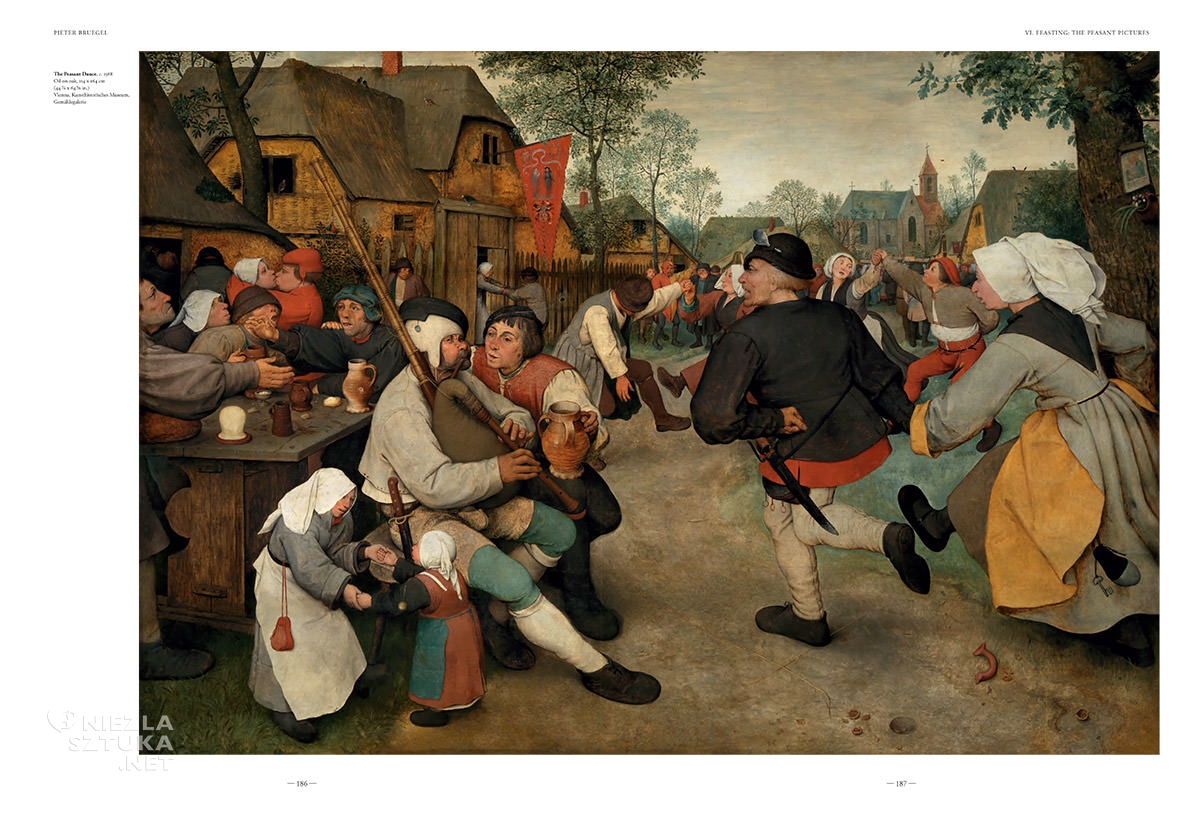
Pieter Bruegel The Peasant Dance , 1567, fot. Dzięki uprzejmości wydawnictwa ⓒ Taschen
This begins with the positioning of the observer at the height of the couple who are rushing in. Our viewpoint does not tally with the picture’s vertical axis, but is shifted into the former direction. We are standing opposite the church tower visible far away in the distance! Despite this, the artist makes the central axis into a sightline, but also accentuates the empty middle ground towards which the couple are heading.
To the left of the table a bagpiper is seated with a table behind him where numerous people have taken their places. Other persons in the middle ground are dancing, watching, or have found their way to the many stands and booths built up for the fair to celebrate the anniversary of the church’s consecration. There is significance in the presence of a jester in a yellow-and-red jerkin, who is standing next to a man cantankerously staring at the scene. Both remind us of the ancient pair of philosophers Democritus (460/59–371 BC) and Heraclitus (c. 520–c. 460 BC), who represented opposite philosophies of life and interpreted the world as a reason either to laugh or to cry. At any event, the jester combines in his costume the two colours that apply to practically all the protagonists.
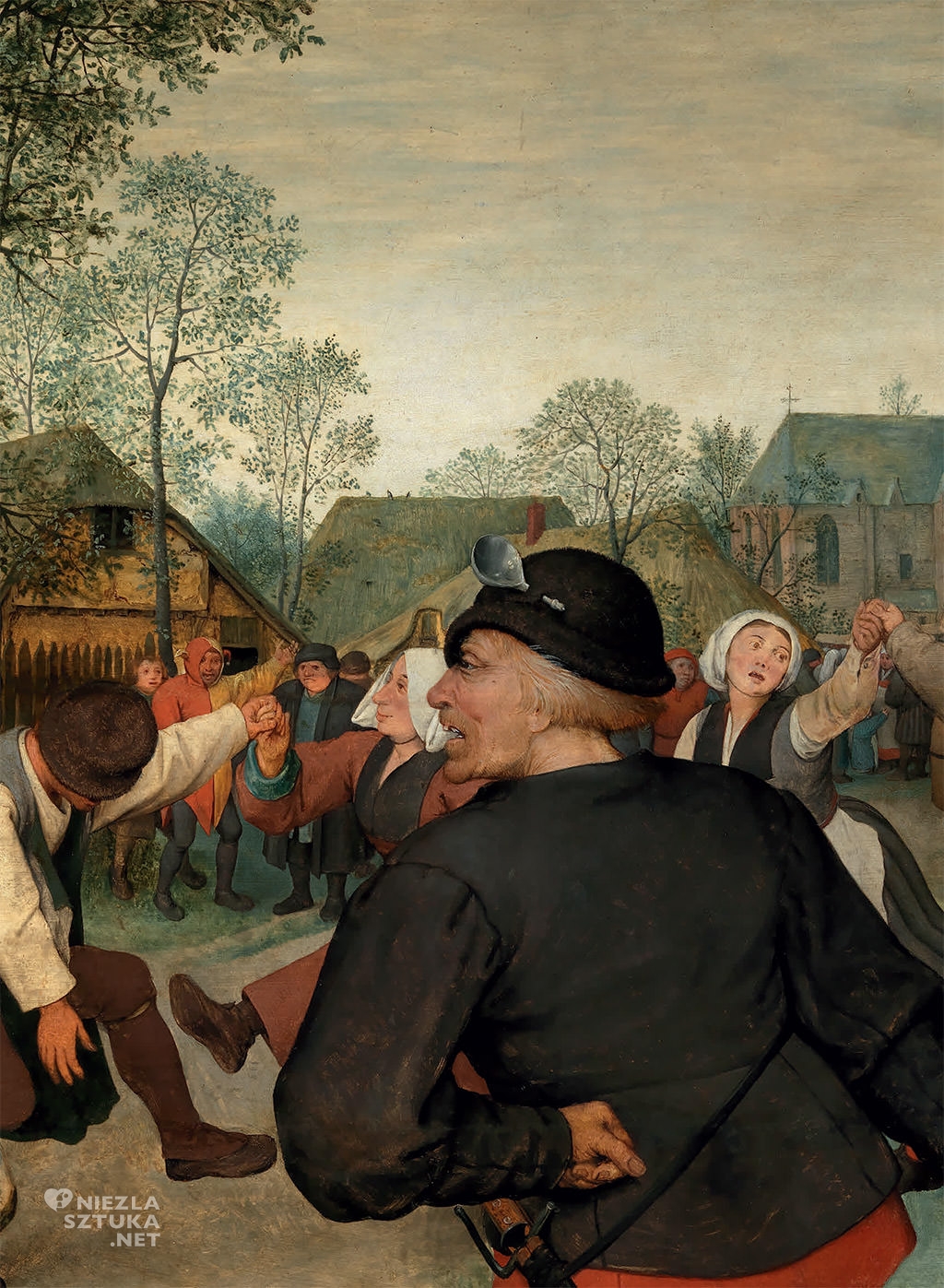
Pieter Bruegel The Peasant Dance detail, 1567, fot. Dzięki uprzejmości wydawnictwa ⓒ Taschen
Confronted by this scene, which indeed makes one laugh but is meant to make one sad, a certain ambivalence enters with the aforementioned couple. Bruegel’s picture has a double meaning. It is humorous in a ribald way, but distances us simultaneously from the peasants. So it was thought that this view of peasants was that of the townspeople, who prefer to keep their distance.
To portray the motifs of the dancing, music-making and drinking peasants, Bruegel makes use of the tradition of pictures of fairs, reminding us of the prints by the Nuremberg “little masters”, but also his contemporary Pieter van der Borcht. However, in contrast to the tradition, Bruegel doesn’t opt for an overall picture, but takes a more intensive close-up view, which grants us a precise study of people’s faces and behaviour. Bruegel studies have even suspected in this context that the artist transposed the standards of history painting to the peasant genre in order to ennoble it. It has been stated furthermore that Bruegel was most interested in displaying the power of the dance and music. Earlier research particularly emphasised the depiction of vice in the picture and interpreted the panel as a critique of a class, mainly because Bruegel takes every opportunity to portray the ugliness and stupidity of these people.
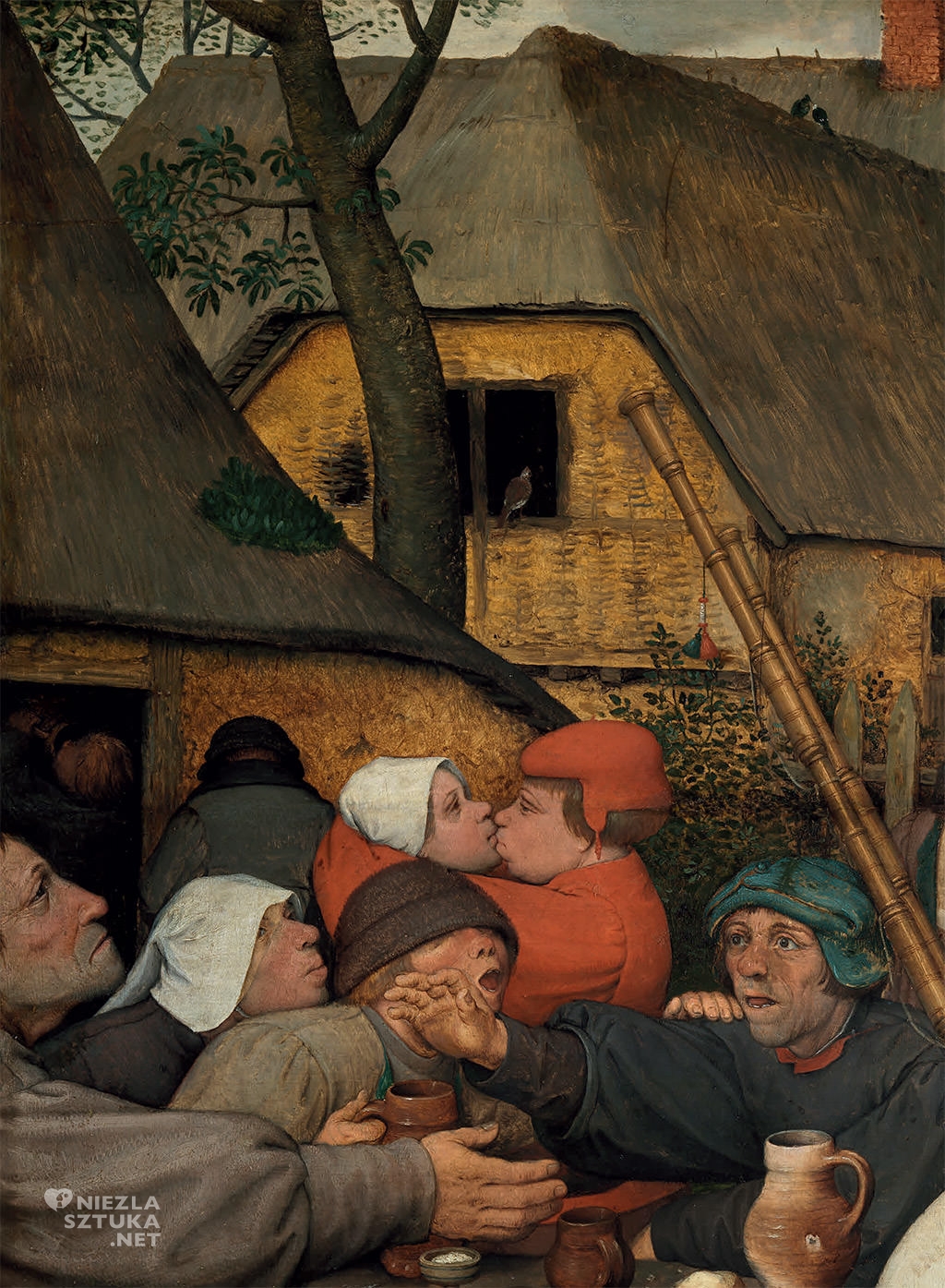
Pieter Bruegel The Peasant Dance detail, 1567, fot. Dzięki uprzejmości wydawnictwa ⓒ Taschen
He achieves this by manipulating the bodies of the protagonists, something we do not immediately note. Thus he gives the impression that the size of the figures in the foreground noticeably diminishes from right to left, which cannot be explained by the laws of perspective. Bruegel uses this trick to make the couple at far right seem even larger and pudgier. Such distortions determine the picture’s composition. The bagpiper’s legs are too long, his torso too short. The girl to his right seems to be dancing with an even smaller child, thus in turn appearing much too small. This pair, clearly imitating the grown-ups, embody the saying “a chip off the old block”, a reference to the incorrigibility of world. Bruegel was also at pains to depict the shoes of the figures in the foreground, all of which are far too big. Ungainly and podgy, the couple barge into the proceedings – a strikingly odd feature is the way Bruegel has depicted the man as though his legs had been attached left for right, and right for left.
The picture dissolves into a variety of more or less amusing scenes, whereby the groups in the foreground draw our attention first. For instance, the bagpiper and the young man with the peacock feather directly next to him are very conspicuously portrayed, the latter characterised as a rake by the feather on his cap. He seems as though he’s trying to bribe the musician with a jug of ale and is cajoling him with great urgency. And while many singles have already found a partner, the young man seems to be out of luck. Perhaps he’s making a special request for music. Perhaps he’s also asking the minstrel to go on playing: because as long as the music is playing, he still has a chance of finding a partner. But his suggestion doesn’t seem to get a positive response; the bagpiper turns away, loath to comply.
Let’s turn once more to the couple rushing in, who seem to be late in joining the party. They bound towards the festive group with boisterous energy. Bruegel has wittily captured this scene by portraying them half running and half dancing. Their hands are already positioned on their hips. The artist presents both persons in profile, but they make an oddly repulsive impression. He resorts to drastic means when he shows the man’s bad teeth and his scurvy complexion. Moreover, the spoon stuck in his cap characterises him as a voracious type. The portrayal of the woman is equally negative, with her bulging eyes, thick lips and receding chin. They bound in haste across the picture as if afraid of missing something. This voracity is what best characterises the couple.
As we scrutinise the events and the details become clearer, we notice the many birds perched on roofs and ridges. They are pigeons set as silhouettes in the scene. This always has a ribald connotation, referring to the Dutch verb “vogelen”, to have sexual intercourse, as we saw already in The Peasant Wedding. At any event, the presence of the pigeons relate to what is happening inside the building. Like the birds, the motifs of bagpipe and the dance have a cryptic erotic meaning.
However, Bruegel does not stop at merely symbolic allusions; many scenes leave nothing to the imagination. Motifs like the kissing couple at far left and another pair far right in the background are in no way inventions of the Flemish artist, but can be found already in the depictions of fairs by the Beham brothers (p. 177). Looking to the right, we can see another pair on the same horizontal axis; here the woman is about to drag the reluctant “cavalier” into the front garden of the house at the rear. The broken-off handle of a jug conspicuously placed next to the female dancer who is rushing in is a symbol of lost innocence.
That the liberal consumption of ale has its consequences is seen in the motif of the man directly behind the kissing couple at the left, who is urinating uninhibitedly against the wall of the house. How the overall festivities will develop becomes clear in the scene at the left. Three men and a woman seated at the table are obviously about to fall out. They all seem drunk, are yelling at each other or wildly gesticulating, apparently without any of them knowing why. The woman is trying to appease her husband but is ignored. The fact that his cap has slipped over his eyes also speaks volumes. We can see a man on the left edge of the picture who is pointing towards the couple rushing to join the party, as if he is the jealous husband who already senses impending adultery. This is indicated by the key, characterising the woman as a married mistress of her house.
In this context, it is significant that all the men are armed. Both the bagpiper and the dancer who is rushing in wear short swords, which incidentally were not allowed to all peasants, solely patriarchs with their own households. Vassals and sons are allowed to carry a knife, as we can see on the dancer at the right, who is wearing red hose. The picture indicates clearly that a violent scuffle is about to take place. We may assess this as a commentary on the consequences of intemperate drinking. It is also interesting that the dancer who is rushing in is looking avidly at the happenings round the table, as if he’s hoping to join in a brawl. Gula (gluttony) is the preliminary to Ira (anger). In this scene, one leads unavoidably to the other.
The off-key ballad on unchastity that Bruegel is striking up first sounds out its shrill tones through the theological context of the village fair, when the saints are celebrated to whom the church is dedicated. In this context, it seems no coincidence that the village church in the background occupies a conspicuously position. It may well be dedicated to the Virgin Mary, which we can perhaps assume from the paper picture of the Madonna attached to a tree on the right edge of the picture. A jug of flowers has been placed in veneration under it. The motif of the crossed ears of grain being trodden on by the dancers is also an eloquent detail, as if Bruegel wanted to suggest the true character of the event: the Cross is being trampled upon.
Fragment pochodzi z książki:
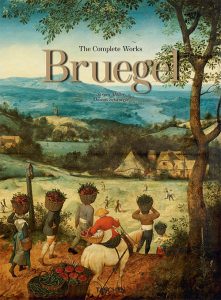
Jürgen Müller, Thomas Schauerte
Pieter Bruegel. The Complete Works »
Taschen
Berlin 2018

